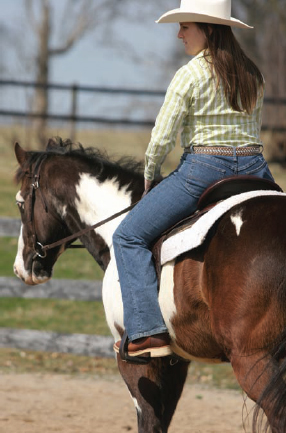
Glossary
aids: The communication signals given from a rider to a horse.
barrel: The area of a horse’s body between the fore- and hindquarters.
barrel racing: A timed contest in which a mounted rider makes sharp turns around three barrels set in a cloverleaf pattern.
bosal: A type of hackamore bridle with a simple noseband made of leather or rope attached to a large knot under the horse’s chin.
breastplate: also called “breastband” or “breast collar;” a device used across a horse’s chest that attaches to the saddle to prevent it from slipping.
bridle: A head harness used to control and guide a horse when driving or riding; usually consists of a headstall and reins with a bit.
canter: A three-beat gait that resembles a slow gallop.
chaps: Leggings worn over trousers (in western riding attire) offering protection against brush, thorns, and cold or wet weather.
cinch: The western term for girth, which is a band that encircles a horse’s belly to hold a saddle on the horse’s back.
crop: A short riding whip with a looped lash.
curb bit: A bit with various mouthpieces and shanks, usually with a center rise that shifts pressure from the tongue to the roof of the mouth.
cutting: A western event during which a horse and rider have 2 minutes to separate an individual calf or cow from the rest of its herd and keep it in the middle of the pen.
deaden: To desensitize a horse’s mouth or sides by excessive use of the aids.
diagonal: The movement of a forefoot in unison with the opposite hind foot.
diagonal pair: A pair of a horse’s legs consisting of a foreleg and the hind leg of the opposite side.
fetlock: A joint that makes a projection on the back of a horse’s lower leg above the back of the hoof.
green horse: A horse, usually a young one, who is inexperienced and not fully trained.
gymkhana games: Informal games, contests, and races on horseback.
hackamore: A type of bridle with a noseband that applies pressure on the nose for control instead of using a standard mouthpiece for control.
headstall: The pieces of a bridle including the cheekstrap, throatlatch, browband, and noseband if used.
high-stepping: Slang for lifting the legs with great animation.
horn: The projection above the raised part in front of a western saddle.
jog: A horse’s slow, measured trot.
lasso: A 30- to 40-foot-long rope with a running noose used for catching horses and cattle.
leading rein: Lifting one rein in an outward direction to encourage the horse to turn his or her head.
lead: Action by the forefoot that takes the first step when entering a canter and while cantering and galloping; a horse on the correct lead is on the right lead when circling clockwise and on the left lead when circling counter-clockwise.
loose rein: A rein that hangs loosely without any pulling or contact between the rider’s hands and the horse’s mouth.
lope: A natural, easy horse gait that is faster than a jog; it has a three-beat rhythm with a pause after the third beat.
lunge: To train or exercise your horse with a lunge line, a whip, and your voice.
lunge line: A rein made of cotton or nylon, about 25 feet long, that attaches to a horse’s halter or bridle.
neck reining: A way of guiding a horse with reins. A mounted rider holds both reins in one hand (usually to the left) and steers the horse by pulling the reins in the direction he or she wants to turn.
position: The carriage of a rider’s body in the saddle.
post: To rise and sit in rhythm with the horse’s trot while riding.
rein hand: The hand that is holding both reins, usually the left hand in western-style riding.
romal: A whip that is attached to a pair of closed reins.
roping: The act of lassoing cattle.
snaffle bit: A type of mild bit.
split reins: Western-style reins that do not join at their ends.
spur: A pointed device that attaches to a rider’s heel and is used as an aid to urge a horse to move by gently pressing the spur into the horse’s side.
tack: Saddle, bridle, and other equipment used in riding and handling a horse.
team penning: A timed sport in which a team of three riders tries to cut three numbered calves out of a herd of thirty and pen them at a designated end of an arena.
transition: A change of pace from one type of movement to another.
tree (saddle tree): The frame of a saddle.
withers: The highest part of a horse’s back, where the neck and the back join.
